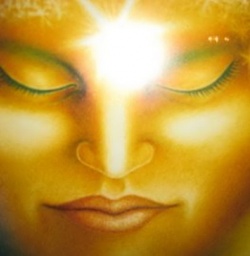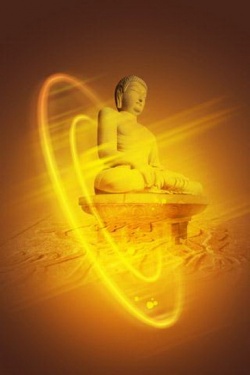The Saha World - The Six Spiritual Realms of Good and Evil
- See also :
- See also :
The First Six Spiritual Realms are known variously as
- The Saha World - the world that must be ‘endured’
- Samsara - the ‘wandering’ or transmigration
- ‘Life & Death’, or ‘Birth & Death’ - The realm of mortal self-existence
- The Wheel of Good & Evil, the cycle of karma & retribution
- The Threefold Realm of desire, form & formlessness
- The 25 States of Existence
It is the realm in which ordinary human existence is said to wander through the countless cycles of Life & Death from the lowest hell (Avici - the unrelenting Hell) to the highest heaven (Akanistha - the ultimate peak of Heaven). In being viewed as six spiritual realms, they are divided into three realms of evil and three realms of good:
The Three Realms of Evil
The Great Calm-Observation says:
- "The mind that breaks the precepts of morality falls into hell,
- The stingy and selfish mind falls into demonic hunger,
- and the unrepentant mind falls into brutality."
1. Hell - (S. Naraka-gati) Hell is suffering. It is pain, imprisonment and the hopelessness of escape. Hell is the result of the three poisons - greed, anger, and stupidity. Hell especially refers to the moral sufferings that are caused by sin (karmic causes of evil) and the breaking of the precepts (commandments or rules of moral conduct). The teaching of the eight hells[1] describes these moral hells in reference to the violation of moral precepts.
2. Brutality - (Tiryagyoni-gati) The animal realm - This refers to shameless, naked aggression, cruelty, and the dog-eat-dog law of the jungle. It is Darwinism, the pitiless survival of the fittest. One has no remorse or shame as one inflicts pain and suffering on others. It involves the naked selfishness of ‘me and mine’, ego and possession.
3. Hunger - (S. Preta-gati) The realm of hungry ghosts - lost, wandering spirits. This refers to insatiable desire, greed, craving and addiction. These cravings are often concealed or denied, and so falsehood and deception are components of this realm. It is also associated with obsession and compulsion.
The Three Good Roads:
The Great Calm-Observation says: “First one takes refuge in the precepts of morality, rejecting falsehood and facing the truth. One calms the fire, the blood, & the sword[2], and reaches the three good paths”.
4. Asuras - (Asura-gati) The forces of one’s personal demons - This refers to forces of competitiveness and the assertiveness of egos, which are always fighting for advantage. This includes the components of ambition, jealousy, envy, doubt, and the need to be better than others. The Great Calm-Observation says: “Always desiring to be superior to others, having no patience for inferiors and belittling strangers; like a hawk, flying high above and looking down on others, and yet outwardly displaying justice, worship, wisdom, and faith - this is raising up the lowest order of good and walking the way of the Asuras.”
5. Humans - (Manusya-gati) The realm of human beings. Having the components of benign personality, a sense of humor, and the indulging in small conceits. It entails being fair with others in the give and take of material things, and not taking from others unless things are freely given. It entails yielding and deferring to benevolence and righteousness. Human beings are tamed and ruled by their leaders (the Wheel Turning Kings - Cakravartins), those who make and enforce their laws. The Great Calm-Observation says: “Rejoicing in worldly pleasures, relaxed in the fragrance of the body and pleased by the foolishness of the mind - this is raising up the intermediate order of good and walking the way of Human Beings.
6. The Gods - (Deva-gati) Heaven - The mastery of desire and the self, joy and contentment, and the progressively deeper states of meditation - The Great Calm-Observation says: “Recognizing that there is so much suffering from the three evil roads, that sufferings and pleasures are intermingled among humanity, and that in heaven above there is a simple happiness; and that to enjoy heaven, the gateways of the six sense faculties must not be left unguarded and the dusts of the five sensations must not be entered into[3]. This is raising up of the highest order of the good mind and walking the way of the Gods.”
There are really more than six spiritual realms, but six serves as a good number to divide them and analyze and understand the the nature of the spiritual realm. There are many gradations of heaven, hell as well as the other spiritual realms, both vertically (in terms of the loftiness of good and the depths of evil states) and horizontally (in terms of different expressions of the same spiritual principle). Rather than viewing these six spiritual realms as six discrete worlds, it would be more precise to view the spiritual realm as a vortex, vertically as a spectrum and horizontally as a wheel. Ultimately, of course, the spiritual realm is without shape, like empty space.
Actually the number of spiritual realms in the Saha World is without limit. There are countless spiritual realms within every living being, much throughout the human race and the whole world. Chapter Sixteen of The Lotus Sutra ('On the Measuring of the Life') says:
- "Compare this to there being a five hundred thousand million billion-fold, countless and ever increasing number of three thousand-fold thousand-fold worlds. Suppose that there is a person that grinds up all these into fine particles of dust and travels eastward though a five hundred thousand million billion-fold, countless and ever increasing number of countries and drops a single particle of dust. This person then continues eastward until all the particles are used up[4].
To properly understand these spiritual realms, it is necessary to understand the principle of their Mutual Possession. Although these spiritual realms can be understood as discrete and identifiable spiritual realms, they are ever penetrating and influencing each other on an individual and collective basis.
Ø Individually, every living being has the capacity for each of these spiritual conditions, which compete with each other for predominance in one’s character. On a simple level, one’s karma (the causes one has made) determines the relative strength and weakness of each of these spiritual conditions in defining one’s character, which is one’s spiritual retribution or reward.
Ø However, no one is an island and we are all part of the collective spiritual reality. Each living being is spiritually penetrated and influenced by one’s environment and the society one interacts with. The spiritual power of a single person can lead many into heaven or hell just as the spiritual power of many can influence a single person.
Footnotes
- ↑ The Eight Hells: Hells caused by violating the precepts of the body, the mouth & the thinking mind
- ↑ The fire (of hell), the blood (of beasts, brutality), & the sword (of the demons of hunger): The three paths of evil
- ↑ The Six Sense Organs: The #1 body #2 nose #3 tongue #4 ears #5 eyes #6 thinking mind – and the The Five Sensations: #1 touch #2 smell #3 taste #4 sound #5 sight (The sixth sensation, the elements of reality (S. dharmas) are not sublimated but rather observed in their pure states.)
- ↑ Five: The Five Aggregates of Self Hundred Thousand Million Billion: The Ten Spiritual Realms, their mutual possession (x 10), and their divisions into more subtle gradations of 10 hells, 100 hells, 1000 hells, 10 heavens, 100 heavens, 1000 heavens etc.etc. Three thousand-fold thousand-fold worlds: Spiritual realms of individuals interacting with society and the land Travels Eastward: The Path, the spiritual journey Drops a Particle of Dust: Dies, and leaves a Legacy All Exhausted: Enters into Parinirvana



